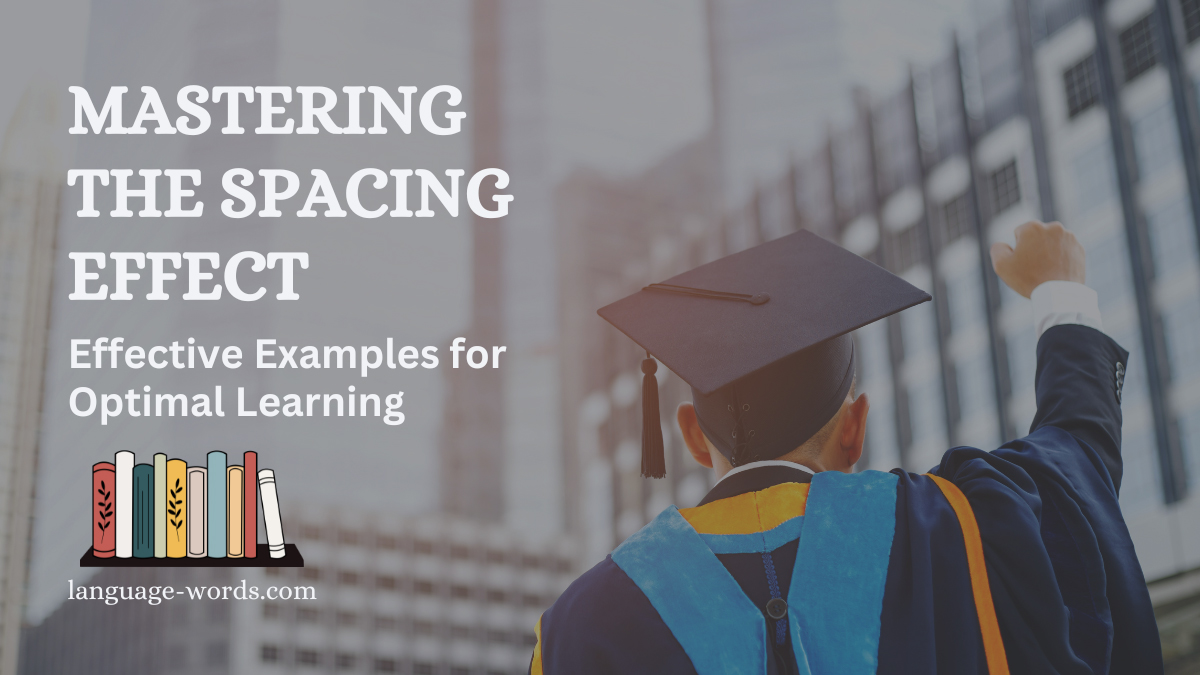Have you ever noticed that when you study or learn something, spacing out your practice sessions can actually improve your retention and recall? It’s called the spacing effect, and it’s a fascinating phenomenon that has been studied extensively in the field of psychology. In this article, I’ll explore some examples of the spacing effect and how it can be applied to enhance learning and memory.
One example of the spacing effect is the concept of distributed practice. Instead of cramming all your study sessions into one long session, spacing them out over time can lead to better long-term retention. For instance, if you’re preparing for an exam, studying for shorter periods over several days or weeks will likely yield better results than studying for hours on end the night before.
Another example of the spacing effect is the use of spaced repetition in language learning. By spacing out your practice of vocabulary and grammar exercises, you can reinforce your knowledge more effectively. This technique is often used in language learning apps and programs, where you are presented with words or phrases at increasing intervals to optimize your learning and retention.
In this article, we’ll delve deeper into these examples and explore the underlying mechanisms behind the spacing effect. So, if you’re interested in boosting your learning and memory, keep reading to discover how the spacing effect can work for you.
What is the spacing effect?
The spacing effect is a phenomenon that suggests spacing out practice sessions improves retention and recall. It refers to the idea that learning is more effective when study or practice sessions are spread out over time, rather than consolidated into one intense session. The spacing effect has been widely studied and observed in various cognitive tasks, including studying, language learning, and memory.

Definition of the Spacing Effect
The spacing effect, also known as spaced learning or spaced repetition, involves spacing out learning sessions with intervals of time in between. Instead of cramming all the information into a single study session, the spacing effect recommends distributing practice and review sessions over a longer period. This allows for better long-term retention and recall of the information.
Explanation of How the Spacing Effect Works
The spacing effect relies on the concept of active recall and retrieval practice. When we space out our practice sessions, we are essentially giving our brain multiple opportunities to retrieve and reinforce the information. Each time we recall the information, our brain is actively engaged in retrieving it from memory, which strengthens the connections and enhances long-term retention.
By spacing out the practice sessions, we take advantage of the brain’s ability to forget and relearn. When we revisit the information after a period of time, our brain has to work harder to retrieve it, which strengthens the memory traces. This process of ‘forgetting and relearning’ encourages deeper processing and encoding of the information, leading to more durable memories.
Importance of the Spacing Effect in Learning and Memory
The spacing effect has significant implications for learning and memory. By incorporating spaced practice into our study habits or teaching methods, we can improve our ability to remember information in the long term. Here are a few reasons why the spacing effect is important:
- Enhanced Retention: Spacing out practice sessions helps prevent forgetting and promotes long-term retention of the material. It allows for more effective encoding of information into long-term memory.
- Improved Recall: When information is spaced out, our ability to recall it becomes more effortless and accurate. The strengthened memory connections enable us to retrieve information easily when needed.
- Optimized Learning: The spacing effect optimizes learning by utilizing the brain’s natural forgetting and relearning processes. It takes advantage of the brain’s ability to reinforce memories through repeated retrieval.
- Time Efficiency: Contrary to popular belief, spaced practice does not require more time than cramming. It allows for efficient use of study time by distributing sessions and maximizing the effectiveness of each practice opportunity.
The spacing effect is a powerful learning technique that can significantly improve retention and recall. By spacing out practice sessions and incorporating active recall, we can optimize our learning and make our memories more durable. It is an important concept to consider in both studying and teaching for better learning outcomes.
Definition List For Examples of spacing effect

Definition List For Examples of the Spacing Effect
The spacing effect refers to the phenomenon where spacing out practice sessions can significantly improve retention and recall. By strategically spacing out our learning and study sessions, we can optimize our memory and enhance our ability to remember information in the long term. Let’s take a look at some practical examples of how the spacing effect can be applied in different learning scenarios:
- Distributed Practice for Studying
Distributed practice involves spreading out your study sessions over a longer period of time, rather than cramming all of your studying into a single session. For example, instead of studying for several hours straight the night before an exam, you could study for shorter periods over the course of a few days leading up to the exam. Research has shown that this distributed practice approach improves retention and recall compared to massed practice (cramming).
- Spaced Repetition in Language Learning
In language learning, spaced repetition is a technique that involves reviewing vocabulary or grammar concepts at increasing intervals over time. Instead of reviewing all the material at once, you review it at specific time intervals, which gradually get longer. For example, when learning new vocabulary words, you might review them immediately, then review them again a day later, then again a week later, and so on. This spaced repetition approach helps reinforce the learning and makes it more likely that the information will be retained in your long-term memory.
- Interleaved Practice in Skill Development
Interleaved practice refers to mixing up different skills or topics during practice sessions. For example, instead of spending an entire practice session working on a single type of math problem, you could mix in different types of problems or switch between different subjects. This variation in practice helps enhance learning by challenging your brain to constantly switch between different concepts and retrieve information from memory, which strengthens your overall learning and retention.
It’s important to note that the spacing effect works through active recall and retrieval practice. By spacing out our learning and practice sessions, we force our brain to actively retrieve information from memory, strengthening the connections and making the information more easily accessible in the future. The spacing effect not only enhances retention and recall but also optimizes learning and improves time efficiency.
Research studies on the spacing effect
Research studies on the spacing effect
When it comes to the spacing effect, numerous research studies have been conducted to explore its effects on learning and retention. Let’s take a look at some of the key studies that have shed light on this powerful learning technique.
Study 1: Effects of spaced and massed practice on retention
In this study, participants were divided into two groups. One group engaged in massed practice, where they repeatedly studied the material in a short period of time. The other group participated in spaced practice, where they spaced out their study sessions over a longer period. The results clearly demonstrated the benefits of spaced practice. The group that utilized spaced practice showed significantly higher retention and recall of the material compared to the group that used massed practice.
Study 2: Comparing various spacing intervals in learning
Another study set out to determine the optimal spacing intervals for learning. Participants were assigned to different groups and were given varying lengths of time between study sessions. The findings revealed that longer spacing intervals, such as days or even weeks, between study sessions led to better long-term retention than shorter intervals. This study highlighted the importance of spacing out practice sessions to enhance learning and improve long-term recall.
Study 3: Examining the long-term benefits of the spacing effect
This study aimed to understand the lasting impact of the spacing effect on learning. Participants were taught a set of information using both massed practice and spaced practice techniques. After a period of time, they were tested on their retention of the material. The results indicated that the spaced practice group outperformed the massed practice group significantly. This research suggests that spacing out practice sessions not only enhances immediate retention but also has a lasting effect on long-term recall.
These research studies provide compelling evidence for the effectiveness of the spacing effect in improving learning outcomes. By spacing out practice sessions and allowing for intervals of time between study sessions, learners can optimize their retention and recall of information. Incorporating this technique into teaching strategies can also lead to better learning outcomes for students.
Remember, understanding the spacing effect and implementing it in teaching can greatly benefit Kindergarten and preschool teachers in helping children learn new words more effectively.
Practical applications of the spacing effect
Practical applications of the spacing effect
The spacing effect has a wide range of practical applications that can benefit both educators and students. Let’s explore some of these practical applications and how they can be implemented effectively.
Spaced repetition software and apps
One practical way to apply the spacing effect is through the use of spaced repetition software and apps. These tools utilize the concept of spaced practice by presenting information at optimized intervals for better retention and recall. With spaced repetition, learners are prompted to review material at gradually increasing intervals, allowing for more efficient learning and long-term retention. This method is especially useful for language learning, where vocabulary and grammar rules can be reinforced over time. By using apps or software that incorporate spaced repetition, teachers can help students reinforce their knowledge in a systematic and effective way.
Incorporating spaced practice in classrooms and educational settings
Another practical application of the spacing effect is incorporating spaced practice into daily classroom routines. Rather than cramming material into a single study session, educators can design lesson plans that space out practice sessions over time. This can involve breaking up learning activities into smaller, manageable chunks and revisiting them periodically. For example, teachers can introduce a new concept, provide guided practice, and then schedule review sessions throughout the week or month to reinforce learning. By spacing out practice sessions, students have more opportunities to engage in active recall and retrieval practice, leading to better long-term retention and improved learning outcomes.
Using the spacing effect for language learning
Language learning can greatly benefit from the application of the spacing effect. By incorporating spaced repetition techniques, educators can help students build a strong foundation of vocabulary and language skills. For example, instead of presenting a large list of words all at once, teachers can introduce a smaller set of words and then revisit them in subsequent lessons. This spaced approach allows students to review and reinforce words over time, leading to better retention and recall. Additionally, educators can encourage students to practice language skills using spaced intervals, such as reviewing vocabulary flashcards at regular intervals throughout the week. By systematically spacing out language practice, students can improve their language proficiency in a natural and efficient manner.
The spacing effect offers practical applications that can enhance learning in various educational settings. Spaced repetition software and apps, incorporating spaced practice in classrooms, and using the spacing effect for language learning are just a few examples of how educators can implement this effective learning strategy. By understanding and utilizing the spacing effect, teachers can provide their students with the tools they need to retain information, improve recall, and optimize learning outcomes.
Tips for optimizing the spacing effect
Tips for Optimizing the Spacing Effect
Establishing a Spaced Practice Schedule
When it comes to optimizing the spacing effect, establishing a spaced practice schedule is key. Here’s how I suggest approaching it:
- Plan regular study sessions: Make sure to schedule regular study sessions to reinforce learning over time. Consistency is key to the spacing effect.
- Break it down: Instead of cramming all the material into one study session, break it down into smaller, manageable chunks. This allows for more effective retention and retrieval.
- Review previous material: Before diving into new content, take a few minutes to review what was learned in previous study sessions. This helps reinforce the information and strengthens the overall learning process.
Varying the Time Intervals Between Practice Sessions
To make the spacing effect even more effective, it’s important to vary the time intervals between practice sessions. Here’s how I recommend doing it:
- Start with shorter intervals: Begin with shorter intervals, such as reviewing the material after a few hours or the next day. This helps solidify the initial learning.
- Gradually increase the intervals: As the learning progresses, gradually increase the time intervals between practice sessions. This could mean reviewing the material after a few days, then a week, and so on. By spacing out the practice sessions, you’re actively engaging with the information at different stages of memory consolidation.
Engaging in Active Recall and Retrieval Practice
Active recall and retrieval practice are powerful tools for optimizing the spacing effect. Here are some strategies I recommend:
- Flashcards: Use flashcards to actively retrieve information from memory. Quiz yourself or have your students quiz each other. This not only reinforces learning but also facilitates active recall.
- Practice questions: Create practice questions based on the material learned. Encourage students to answer these questions without referring to their notes or textbooks. This promotes retrieval practice and strengthens memory consolidation.
- Self-reflection: After each practice session, encourage students to reflect on what they’ve learned. This helps them consolidate their understanding and identify areas that need further review.
Common Misconceptions about the Spacing Effect
Common misconceptions about the spacing effect
When it comes to the spacing effect, there are a few common misconceptions that I’d like to address. These misconceptions often lead to ineffective studying techniques and hinder optimal learning outcomes. In this section, I will debunk these misconceptions and provide clarity on the true power of the spacing effect.
Misconception 1: Cramming is more effective than spaced studying
One misconception that many people have is that cramming – studying a large amount of material in a short period of time – is more effective than spaced studying. However, research consistently shows that this is not the case. While cramming may give the illusion of mastery in the short term, it does not lead to long-term retention of information.
Cramming leads to forgetting. When we cram, our brains perceive the information as less important and therefore tend to forget it quickly. On the other hand, spacing out your study sessions allows for better consolidation of information and enhances long-term memory.
Misconception 2: The spacing effect only applies to academic subjects
Another common misconception about the spacing effect is that it only applies to academic subjects such as math, science, or history. However, this is far from the truth. The spacing effect is a universal learning strategy that can be applied to any type of learning, including language learning, skill acquisition, and even physical training.
The spacing effect improves learning in all areas. Whether you’re teaching children new words, helping them learn how to count, or even practicing fine motor skills, using spaced repetition can significantly enhance learning outcomes. By incorporating regular review sessions into your teaching routine, you can ensure that the knowledge is retained over time.
Misconception 3: The spacing effect is only applicable to short-term memory
Some people mistakenly believe that the spacing effect is only applicable to short-term memory. However, this is a misconception that underestimates the true potential of spaced practice.
The spacing effect enhances long-term memory. By spacing out your study sessions, you are strengthening the connections in your brain and promoting better retention of information over an extended period. This long-term retention allows for better recall and application of knowledge when it matters most.
In debunking these misconceptions, it becomes clear that the spacing effect is a powerful tool that can revolutionize learning and teaching. By incorporating spaced practice into your teaching strategies, you can maximize the effectiveness of learning and ensure that the knowledge sticks with your students in the long run. Keep in mind that these misconceptions may have influenced your teaching methods in the past, but now armed with the knowledge of the spacing effect, you can unlock the true potential of learning for your students.
Conclusion
In this article, we have explored the power of the spacing effect as a learning strategy. By spacing out study sessions, we can optimize retention and recall, debunking common misconceptions along the way. Contrary to popular belief, cramming is not more effective than spaced studying. Additionally, the spacing effect is not limited to academic subjects or short-term memory.
We have learned that spacing out study sessions allows for better consolidation of information, leading to enhanced long-term memory. This strategy can be applied to any type of learning, revolutionizing teaching strategies. Educators can maximize the effectiveness of learning by incorporating spaced practice into their teaching routines, ensuring that knowledge is retained in the long run.
By understanding and harnessing the spacing effect, we can improve our learning and memory capabilities. So, whether you’re a student, a professional, or simply someone looking to expand your knowledge, remember the power of spacing out your study sessions. It’s a simple yet effective way to enhance your learning journey.

